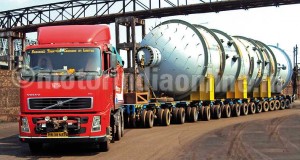 Heavyweight class has its own charm, utility and niche space in any equipment domain and CV market 49 ton class is no exception to it. This segment has seen many players enter the fray in the recent years to claim their share of business concomitantly expanding with increased economic activities and healthy GDP growth rate. The current downturn however has put the brakes on the CV domain business and one of the segments to take a severe beating has been the tractor trailer (35-49 ton range) which depends heavily on the vibrancy of core sector and infrastructure/project activities. This scenario is expected to change in the near future and we should soon be seeing the tractor trailers take over the highways in a big way and play their active role in the economy building exercises.
Heavyweight class has its own charm, utility and niche space in any equipment domain and CV market 49 ton class is no exception to it. This segment has seen many players enter the fray in the recent years to claim their share of business concomitantly expanding with increased economic activities and healthy GDP growth rate. The current downturn however has put the brakes on the CV domain business and one of the segments to take a severe beating has been the tractor trailer (35-49 ton range) which depends heavily on the vibrancy of core sector and infrastructure/project activities. This scenario is expected to change in the near future and we should soon be seeing the tractor trailers take over the highways in a big way and play their active role in the economy building exercises.
49 ton marks the upper limit of GCW (Gross Combination Weight) of tractor trailer permissible under Central Motor Vehicles Rules (CMVR) 1989; the trailer in the subject category being a semi-trailer getting attached thro’ the fifth wheel coupler to the tractor or the truck-trailer combination. In the case of the 49 ton tractor semi-trailer, the popular version in use, the combination works out to 3 axle tractor 6X4 drive (6 ton on front axle, 19 ton on rear tandem axle & together 25 ton) coupled to 3 axle or tridem axle (24 ton on 3 axles) semi-trailer; and the legal payload working out to an average of 32 ton. To carry heavier loads essentially ODC up to 1000 ton or more, the 49 ton GCW tractors are deployed as pullers in conjunction with drawbar modular hydraulic trailers- such applications necessitating approvals to be taken for each ODC transport project from the Ministry of Road transport & Highways. To understand the evolution of this segment, popular applications, players in the field, growth drivers, challenges and future path, we met some of the domain specialists to get their insights- read on for the significant observations.
Evolution

The evolution process in the trailer domain began with the 35 ton 2 axle tractor coupled to a tandem axle semi-trailer, points out Mr. M. Sriram, CEO, Race Innovations Pvt. Ltd., a leading automotive consultancy, research and engineering services firm. He says: “The 3 segments that are popular in the trailer domain include 35 ton, 40 ton and the 49 ton. 40 ton was the 2nd stage in the evolution and by far the most popular of the three as of now – the combination being the 2 axle tractor coupled to a tridem axle semi-trailer. The demand for the transport of heavier loads, following the similar international trends, led to the entry of heavyweight 49 ton tractor trailer in the 3rd stage, viz., 3 axle tractor with tridem axle semi-trailer. The trailer class (with front and rear axles) falling under the CMVR has never clicked and almost does not exist in the Indian scenario. Some attempts were made in the past to couple it with truck/tractor but the model never found the acceptance in the marketplace-hence it’s either the semi-trailer (default reference ‘trailer’ in the domain) or the modular trailer (referred also as modular hydraulic axles or trailers) for applications in India”. The modular trailers for movement of loads up to 1000 ton or more (internationally even up to 3000 ton) are merely an application segment for the 49 ton tractor, the same having higher hp (400 to 500+ HP) and performing the task as pullers, he adds.
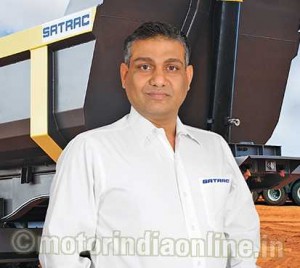
Mr. N. Thillaiarasan, Director – Projects, Namakkal Transport Carriers, specialising on ODC segment points out that they have been using tridem axle trailer from early 2000s of the last decade for their heavy duty material transport and ODC applications. He adds: “For the subject applications initially we utilised for 40 ton 2 axle tractor with the 3 axle trailer and after mid 2000s, shifted to the 49 ton 3 axle tractor with tridem axle trailer. For the demanding applications and the need to move heavy project cargo, we opted for the 49 ton tractor with modular trailer combination. Currently in our fleet, we have less than 10% of tandem axle trailer and the 49 ton class 3 axle tractor forms the core choice for both tridem axle trailer and modular trailer applications”.
Mr. M.C. Bantwal, Director, Satrac Engineering Pvt. Ltd., a leading trailer manufacturer indicates that the real take-off for the 49 ton happened around the year 2008 when good many nos. were deployed for the movement of bulk materials. Considering the cost per ton-km being the lowest in the 49 ton tractor trailer application, the market for the same has grown steadily over the period of time, he adds. Mr. K. Ramesh Charry a trailer domain veteran and Managing Director of Sai Baba Fabrication, says: “I see a distinct trend of the market moving towards 49 ton segment in future. 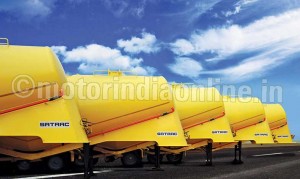 Whilst increasing number of customers opt for payload trailers which conform to the CMVR, some customer segments still opt for 49 ton tractor with tridem axle trailer to carry loads up to 70 ton or more – in machinery transport, granite handling and miscellaneous ODC applications. With implementation drive of axle loading rules and regulations getting stronger, I see a significant increase in demand for the 49 ton tractor – more of payload trailers would be used for diverse applications and heavier loads transported thro’ modular trailer route. The Mantra of ‘lighter trailer for more payload’ will eventually replace the ‘heavier trailer for higher payload’ practice – the paradigm shift is bound to take place and we are on the right track”.
Whilst increasing number of customers opt for payload trailers which conform to the CMVR, some customer segments still opt for 49 ton tractor with tridem axle trailer to carry loads up to 70 ton or more – in machinery transport, granite handling and miscellaneous ODC applications. With implementation drive of axle loading rules and regulations getting stronger, I see a significant increase in demand for the 49 ton tractor – more of payload trailers would be used for diverse applications and heavier loads transported thro’ modular trailer route. The Mantra of ‘lighter trailer for more payload’ will eventually replace the ‘heavier trailer for higher payload’ practice – the paradigm shift is bound to take place and we are on the right track”.
Market segments & OEMs
“40 ton and 49 ton class tractor trailer invariably cross each other in many of the applications. We have been traditionally wedded to the haulage application be it the cement, steel, bulker or open cargo transport applications. Both the 40 & 49 ton class can be considered for many of the transport tasks but the cost economics and other technical considerations prompt the customers to zero in on the applicable model. If the ‘roads and loads are no issues’, 49 ton tractor trailer is the logical choice”, opines Mr. Sriram. Mr. Bantwal indicates: “Bulk movement of commodities like coal, limestone, fly ash and cement is one of main application segments. If the hub and spoke model becomes popular, then for the long haul, viz., from factory to the hub, 49 ton tractor trailer would be the optimal choice; and from the hub to the dealers, in the spoke zone of the model, distribution trucks are well suited for short haul and can take charge of the lower payload delivery – widely opted by many of the smaller traders. The other application is in the ODC movement that requires a powerful prime mover, the typical applications being in movement of project machinery, windmill blades, sub-assemblies and granite material”.
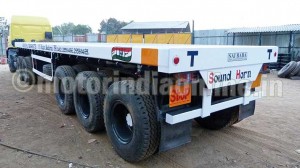 Most of the leading OEMs are present strongly in the segment. Tata and Leyland are popular in the general goods/bulk material haulage segment; AMW and MAN for heavy machineries/loads and ODC movement thro- semi trailers while Volvo and Scania in the ODC puller class thro’ modular trailers. The make and model preference depend upon factors like fuel efficiency, engine power, reliability, service network, driving comfort, price and quality; and continuously the OEMs are working towards increasing their market share, offering more models and working towards specific applications. Customers are also and guided by market feedback and opt for the stronger OEMs in their operational segments. New entrants like Bharat Benz, Mahindra and VECV are aggressively positioning their models for the diverse applications and with the market take-off, all the players should find their stronger and favourite markets and start focusing on the same for nos. – refer to the popular models of OEMs in the section indicated separately following this overview.
Most of the leading OEMs are present strongly in the segment. Tata and Leyland are popular in the general goods/bulk material haulage segment; AMW and MAN for heavy machineries/loads and ODC movement thro- semi trailers while Volvo and Scania in the ODC puller class thro’ modular trailers. The make and model preference depend upon factors like fuel efficiency, engine power, reliability, service network, driving comfort, price and quality; and continuously the OEMs are working towards increasing their market share, offering more models and working towards specific applications. Customers are also and guided by market feedback and opt for the stronger OEMs in their operational segments. New entrants like Bharat Benz, Mahindra and VECV are aggressively positioning their models for the diverse applications and with the market take-off, all the players should find their stronger and favourite markets and start focusing on the same for nos. – refer to the popular models of OEMs in the section indicated separately following this overview.
Growth drivers
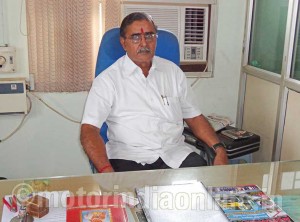
On the macro level, growth for the segment is undoubtedly linked to the healthy economy with the GDP growth rate hovering in the 8+% band. On the micro market level, several factors can stimulate the demand, same subject to efficient administrative measures. “Effective implementation of axle loading regulation and updating the motor vehicles rules in sync with the changing trends in the project cargo handling arena would ensure that 40 ton tractor trailer operators gravitate towards the 49 ton segment; and the payload trailers would become the norm leading to the nos.”, summarises Mr. Ramesh. Mr. Sriram indicates: “Operators having assured business in the long haul routes would definitely look at the possibility of deploying 49 ton model – with fewer no. of trips and drivers to maximise the operational economy or carrying more load with the set-up to improve the top and bottom lines. Though 40 ton class tractor would continue to remain the dominant section like in developed countries, the 49 ton nos. will increase significantly”. Mr. Bantwal opines that combination of load restriction, hub and spoke model utilising 49 ton segment for long haul, GST implementation, looming driver shortage can act as the accelerators for the growth. Mr. Thillaiarasan is more candid and feels that for the 49 ton nos. to increase on the ODC segment, the projects and infrastructure segments dormant at the current juncture will have to get back into the full stream at the earliest; and all the other measures can only play a secondary or supporting role.
To summarise, 49 ton segment tractor take-off on the fast lane is a certainty and the market share for the segment in the CV domain expected to align in line with that witnessed in developed countries. Increasing connectivity, more no. of world-class highways, higher HP models for ensuring a faster turn around, enforcement of rules/regulations and the need to contain the rising operational costs should be some of the key factors in fleet operators settling in favour of 49 ton tractor in the future. From playing a minor role in the past decade, the 49 ton segment tractor should soon emerge out of the shadows of the 40 ton class tractor and become one of the dominant forces to reckon with in the CV market, a position it richly deserves.
Tranztar CV Applications Ltd
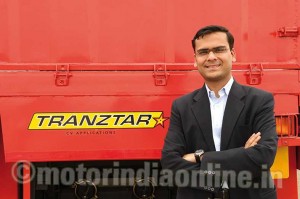
Tranztar manufactures varied trailer models at its parent company AMW’s state-of-the-art Bhuj plant in Gujarat that include Flat bed, Side board, Tipper, Oil tanker, Customised-ODC and Modular. Read on for the excerpts of comments on various issues by Mr. Nitin Chamaria, Tranztar CEO.
Performance of 49 ton tractor trailer (Tr-Tr) in the marketplace during short/ medium/ long terms
* The overall Tr-Tr market in India is down by as much as 56% in last 2 years.
* Naturally, 49T segment was also affected but more so because of multiple factors related to infrastructure, projects and trade slow down.
* In long term, with the debottlenecking of economic growth and introduction of GST, it should give a strong momentum to this segment.
* We at Tranztar are bullish on this segment. We also expect customers to switch to this segment over 40T gradually and demand for higher GVW and high performance Trucks.
Growth drivers for the 49 ton Tr-Tr segment and the popularity of modular trailers with 49 ton tractor
* Better road infrastructure.
* Markets are gradually moving towards higher hp Trucks.
* Increase in fleet utilization and efficiency.
* Customers demanding faster turnaround timings.
* Demand for higher GVW vehicles.
* Hub and spoke model.
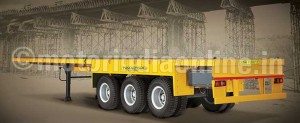 Modular Trailers have not picked up in demand in India as per potential except for some ODC segment. However, we do expect this segment to improve in future. 6×4 Tractors are very popular in this segment.
Modular Trailers have not picked up in demand in India as per potential except for some ODC segment. However, we do expect this segment to improve in future. 6×4 Tractors are very popular in this segment.
Trailer mfrs in the organised/unorganised sector and overloading trend
Even today the Trailer market in India is highly unorganized. Even in the organized sector, there is a shortage of good quality Trailer manufacturers that match up to global standards. This is largely due to absence of a strict Trailer code or standard that is applicable for all Trailers manufactured in India, including up to its component level. We have been able to match up to global standards other automotive regulations but are short for Trailers yet. It is also one of the reasons why we still have such high rates of breakdowns and accidents happening on our roads.
Yes, we need better regulation and higher enforcement at all levels to control over loading in the country.
Transport Solutions India (P) Ltd.

Mr. Manoj Varghese, National Head – Sales, TSI Group, Pune, discusses various aspects of the trailer segment and 49 ton class. Excerpts from his observations:
Popular trailer models and applications in 49 ton segment
TSI has various range of trailers used with a 49 Ton Tractor
• 3 Axle Flatbed – Coil, Container, Sheets, etc.
• 3 Axle Box Trailers – Ore, Cement, Edible grains, Pellets, etc.
• 3 Axle Semi Low Bed – Earth Moving Equipment, Containers, Heavy machinery, etc.
• Steering Axle Semi Low bed: Defence application
Co-operation with vehicle OEMs and role of trailer mfrs in segment growth
Being a major manufacturer in the industry, we have always made it a point to understand and discuss with the customer, his transport operations and then advise the correct combination for him. With the local tie-up with all the dealers of the truck mfrs, we try to give the customer, the best trailer as per his requirement.
Transport Solutions India currently caters to Truck Manufacturers like MAN and Mahindra to provide a solution for the customer to have a complete unit as per the customer’s requirement.
Overloading and ODC class
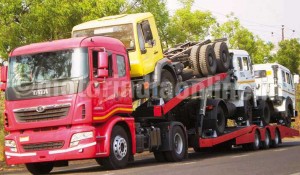 Overloading has been a perennial problem in the industry and the core reasons are never taken care of, ex: the fuel and product costs increase on a regular basis but the transport rates are still not fixed, the contracts given by companies are sometime not viable if the transporters do not overload. This is one of the major reasons why the 35 and 40 ton tractors will phase out in the future.
Overloading has been a perennial problem in the industry and the core reasons are never taken care of, ex: the fuel and product costs increase on a regular basis but the transport rates are still not fixed, the contracts given by companies are sometime not viable if the transporters do not overload. This is one of the major reasons why the 35 and 40 ton tractors will phase out in the future.
ODC is a requisite in the country with all the infrastructure and development happening here. However my question is that why overload? Why not provide roads that are designed to carry such loads? Why not provide trucks which are designed to carry heavier loads? Why not get technology like Freightliner, Volvo VNX Series, etc.?
Supply and demand gap
Supply and demand gap needs to be understood in a different manner against the current operations. We need to enforce a law to off-road old trucks that are plying in various cities. If a 15 year rule is passed for trucks, it would show better operation standards and increase the gap in supply and demand.
BPW Trailer Systems India Pvt. Ltd.

Mr. Philipp Baecker is the General Manager of BPW India (subsidiary of BPW, Germany) having its India operations centre located at Gurgaon; they are a system-manufacturer for trailer axles, suspension (mechanical & air suspension) and other accessories. Excerpts of his viewpoints on the subject follow.
Performance of 49 ton tractor trailer in the marketplace during short/ medium/ long terms
In the short term we still see the 49t tractor trailer segment struggle – as India still has not created the legal framework & infrastructure for the benefits of the 49t segment.
Legal framework that needs to be improved:
– GST
– Trailer code
– Professional homologation
– Safety standards
– Ban of overloading
– Flexible registration of truck and trailer
Infrastructure that needs to be improved:
– Bigger warehouses (logistic centres). Warehouses often don’t even have the capability to unload a 40t trailer (no forklift, no proper staff, etc.)
– Improved cold chain warehousing
– Hub and spoke model
– Road quality
In the mid and long-term the tractor-trailer is the only viable solution for an efficient economy!
The mid and light segment range will be used for inner – city transportation and delivery from large logistic hubs to deliver to single customers/ distribution logistic.
Role of trailer mfrs in complementing the growth for the segment
The trailer mfrs need to increase their maturity level.
As the tractor segment is ruled by highly organized players (TATA, AMW, Scania, Bharat Benz, Volvo, etc.). This means that trailer mfrs also need to increase their maturity level to deliver world class products.
It is a waste of efficiency and loss of potential to use a world class truck with a trailer built on the roadside with e.g. old railroad axles.
India needs trucks and trailers which the economy can rely on. Trailer need to become more reliable, maintenance friendly, and add more features. A standard flat bed trailer is not enough in the mid and long-term. We need to protect the goods and add safety features as superstructure, strapping systems and most importantly cooling function for a reliable cold chain logistic.
International trends vis-à-vis India developments in the 49 ton class–sales volume & technical features, both in the tractor and trailer class
International trends are focused on the increase of efficiency and performance – to reduce emission and to cater to the customers tailor made solutions for the transport segment. We see a big trend in the speaking trailer which informs the driver interactively about the status quo of the vehicle – brake performance – tire pressure – even bearing temperature and load sensing which guarantees damage free cargo transportation.
The sales volume depends on the economic situation of the country. As stated before the trailer/commercial vehicle industry is closely connected to the overall economic situation of a country. Of course some markets like Europe are more saturated than others such as India or South America.
India needs to improve the quality standards for trailers in order to reduce road accidents and increase efficiency and reliability.
We will also see a trend in India of added features in the trailer structure and diversified trailer application such as air suspension, special steering systems for special cargo like windmill blades, cooling features for efficient cold chain, superstructure to protect the load, increased use of telematics and fleet management systems to monitor the performance and reduce TCO. In addition there will be a closer cooperation between component manufacturer, trailer mfrs., truck mfrs. and end customer, meaning more efficient transport solutions along the distribution chain.
York Transport Equipment (Ind) Pvt. Ltd.
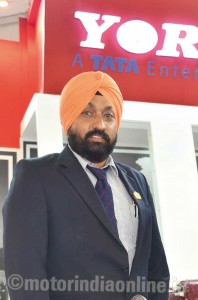
York (India), a Tata enterprise belonging to York group HO, Singapore has its corporate office and manufacturing location at Pune. It supplies a wide range of axles, suspension and other trailer components and includes axles and suspensions in the range from 12 ton to 18 ton. York is offering 13 Ton (Q13) axle with 15 ton (75/90) mechanical suspension for 49 ton segment. Read on for the segment impression excerpts of Mr. Gurmukh Singh, Head (Service, product application, OEM marketing).
Performance of 49 ton tractor trailer in the marketplace during short/ medium/ long terms
49 Ton tractor is carrying extra 7 ton payload compared to 40 ton tractor with marginal increase in diesel consumption. Most of the other running costs like tyres, tractor maintenance and driver expenses are almost same. This makes a good sense to shift on high end 49 ton tractor trailer combination from 35/40 ton tractor segment.
Small operators who were using 35 Ton tractors with 23 ft side wall trailers have shifted to either 40 Ton tractors with 28/30 ft side wall trailer options or LPT 3118 rigid trucks. Currently 35 Ton prime movers are mostly used in cryogenic tanker segment. Scarcity of good drivers, continuous increase in the running cost is forcing the transporters to shift to 49 Ton tractor for higher profitability.
Growth drivers for the 49 ton tractor trailer segment; and the popularity of modular trailers with 49 ton tractor
Driving Skills: States where tractor drivers are easily available even small fleet operators prefer tractor trailers like Rajasthan market. Availability of good tractor drivers is the major factor for the growth of tractor trailer segment.
Type of ownerships: Small fleet operators prefer to remain with multi axle rigid trucks instead of switching over to tractor trailer. Multi axle trucks provide greater flexibility to carry different kind of goods and assure better utilization compare to tractor trailer for small fleet operators who are depending on market load.
Segment: Fleet operators running their vehicles in steel, cement, coal, automobile and port industries prefer for Prime movers and these customers will keep on improving their fleet size once these industries will catch up the growth path. Whereas small operators operating in agriculture & FMCG Industries, who are uncertain for return load will prefer the multi axle trucks only.
Future trend: 35/40 Ton segment is shifting to 49 Ton tractor in highway segment very soon. Most of the states are imposing heavy penalty on the overloading, which is forcing fleet operators to switch on 49 ton tractor trailer to ensure viability of their operations.
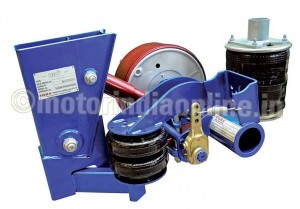 Due to overload restriction, fleet operators prefer lower unladen weight of tractor / trailer components to improve their payload capacity. OEM and trailer manufactures focus is shifting towards reduction in unladen weight of their tractors / trailers by maintaining the same strength.
Due to overload restriction, fleet operators prefer lower unladen weight of tractor / trailer components to improve their payload capacity. OEM and trailer manufactures focus is shifting towards reduction in unladen weight of their tractors / trailers by maintaining the same strength.
Role of trailer mfrs in complementing the growth for the segment
Trailer manufactures are designing the trailers to provide better flexibility to carry various types of loads e.g., some of the trailer manufactures have developed chassis carrier which can carry steel coil and agriculture tractors also.
Trailer manufactures are fabricating car carriers with the option of carrying also two wheelers. Organised trailer manufactures are providing trailers with branded aggregates to provide low cost of ownership with adequate safety to their fleet operators.